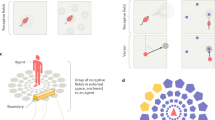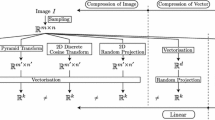Abstract
Analysis of matrixes consisting of the numbers of spikes evoked by the movement of simple and complex stimuli in cat visual cortex neurons by the principal components method demonstrated vector encoding. The responses of direction detectors to the movement of points and orientation detectors to changes in the angle of a line were encoded independently in areas V1 and V2 of the cortex. Each type of detector was represented by excitation of two cardinal neurons generating sine and cosine functions. The responses of neurons in the associative cortex with selectivity for the direction of movement of specifically oriented bars depended on four cardinal neurons formed by summation of the excitations of the cardinal neurons of the directional and orientational channels.
Similar content being viewed by others
References
I. I. Ketleris, Detection of the Movement of Objects by Neurons in the Rabbit Visual Cortex [in Russian], Author’s abstract of thesis for doctorate in biological sciences, I. P. Pavlov Institute of Physiology, Leningrad (1979).
Dictionary of Physiological Terms [in Russian], Nauka, Moscow (1987).
E. N. Sokolov and H. Vaitkevicius, The Neurointellect [in Russian], Nauka, Moscow (1989).
A. Ya. Supin, Neural Mechanisms of Visual Analysis [in Russian], Nauka, Moscow (1974).
R. Satinskas, D. Stabinyte, A. Pleskacauskas, and H. Vaitkevicius, “Effects of the brightness ratio and the angle between the trajectories of movement of two stimuli on the perception of the direction of movement of one of the stimuli,” Psikhologiya, 24, 58–68 (2001).
R. Satinskas, D. Stabinyte, A. Pleskacauskas, A. Shvegzda, H. Vaitkevicius, and E. N. Sokolov, “ Encoding of stimulus motion parameters in the cat visual system: I. Studies of the responses of directionally sensitive neurons to the movement of a spot in the receptive field,” Sensor Sistemy, 5, No. 2, 107–113 (2003).
T. J. Andres and D. Schluppeck, “Ambiguity in the perception of moving stimuli is resolved in favour of the cardinal axes,” Vision Res., 40, 3485–3493 (2000).
H. B. Barlow and W. R. Levick, “The mechanism of directionally selective units in rabbit’s retina, ” J. Physiol., 178, 477–504 (1965).
O. J. Braddick, “Low-level and high-level processes in apparent movement,” Phil. Trans. Roy. Soc. London, 290, No. 1038, 137–151 (1980).
V. Brice, P. R. Green, and M. A. Georgeson, Visual Perception (Physiology, Psychology and Ecology), Psychol. Press (1996).
D. C. Burr, D. R. Badcock, and J. Ross, “Cardinal axes for radial and circular motion, revealed by summation and masking,” Vision Res., 41, No. 4, 473–481 (2001).
B. Dreher, C. Wang, K. J. Turlejsky, R. L. Djavadian, and W. Burke, “Areas PMLS and 21a of the cat visual cortex: two functionally distinct areas,” Cerebr. Cortex, 6, 585–599 (1996).
E. Grossman and R. Blake, “Perception of coherent motion, biological motion and form-from-motion under dim-light conditions,” Vision res., 39, 3721–3727 (1999).
G. Johansson, “Visual perception of biological motion and a model for its analysis,” Percept. Psychophysics, 14, No. 3, 201–211 (1973).
M. B. Mandler and W. Makous, “A three channel model of temporal frequency perception,” Vision Res., 24, 1881–1887 (1984).
B. R. Payne, “Evidence for visual cortical area homologs in cat and macaque monkey,” Cerebr. Cortex, 3, 1–25 (1993).
I. N. Pigarev and E. I. Rodionova, “Two visual areas located in the middle suprasylvian gyrus (cytoarchitectonic field 7) of the cat cortex,” Neurosci., 85, 717–732 (1998).
N. Qian, R. A. Andersen, and E. H. Adelson, “Transparent motion perception as detection of unbalanced motion signals. I. Psychophysics,” J. Neurosci., 14, No. 12, 7357–7366 (1994).
W. Reichardt and T. Poggio, “Figure-ground discrimination by relative movement in the visual system of the fly,” Biol. Cybernetics, 35, 81–95 (1979).
O. Ruksenas and R. Satinskas, “Sympathectomy and d-tubocurarine chloride in immobilisation of the eye in the cat,” Scand. J. Lab. Amin. Sci., 23, No. 1, 425–430 (1996).
A. T. Smith and W. Curran, “Continuity-based and discontinuitybased segmentation in transparent and spatially segregated global motion,” Vision. Res., 40, 1115–1123 (2000).
A. T. Smith, N. E. Scott-Samuel, and K. D. Singh, “Global motion adaptation,” Vision Res., 40, 1069–1075 (2000).
K. Toyama, K. Fuji, and K. Umetani, “Functional differentiation between the anterior and posterior Clare-Bishop cortex of the cat,” Exptl. Brain Res., 81, No. 2, 221–233 (1990).
K. Toyama, H. Kitaoji, and K. Umetani, “Binocular neuronal responsiveness in Clare-Bishop cortex of Siamese cats,” Exptl. Brain Res., 86, No. 3, 471–482 (1991).
J. Touryan, B. Lau, and Y. Dan, “Isolation of relevant visual features from random stimuli for cortical complex cells,” J. Neurosci., 22, No. 24, 10811–10818 (2002).
M. J. Wainwright, “Visual adaptation as optimal information transmission,” Vision Res., 39, 3960–3974 (1999).
S. N. Watamaniuk and R. Sekuler, “Temporal and spatial integration in dynamic random-dot stimuli, ” Vision Res., 32, 2341–2347 (1992).
S. N. Watamaniuk, R. Sekuler, and D. R. Williams, “Direction perception in complex dynamic displays: the integration of direction information,” Vision Res., 29, 47–59 (1989).
D. W. Williams and R. Sekuler, “Coherent global motion perception from stochastic local motion, ” Vision Res., 24, 55–62 (1984).
S. M. Zeki, “Functional organization of a visual areas located in the posterior bank of the superior temporal sulcus of the rhesus monkey,” J. Physiol. (Eng.), 236, 549–573 (1974).
Author information
Authors and Affiliations
Additional information
__________
Translated from Zhurnal Vysshei Nervnoi Deyatel’nosti imeni I. P. Pavlova, Vol. 56, No. 2, pp. 228–235, March–April, 2006.
Rights and permissions
About this article
Cite this article
Sokolov, E.N., Satinskas, R., Stabinyte, D. et al. Encoding of stimulus movement parameters in the cat visual system. Neurosci Behav Physiol 37, 395–402 (2007). https://doi.org/10.1007/s11055-007-0026-3
Received:
Accepted:
Issue Date:
DOI: https://doi.org/10.1007/s11055-007-0026-3




